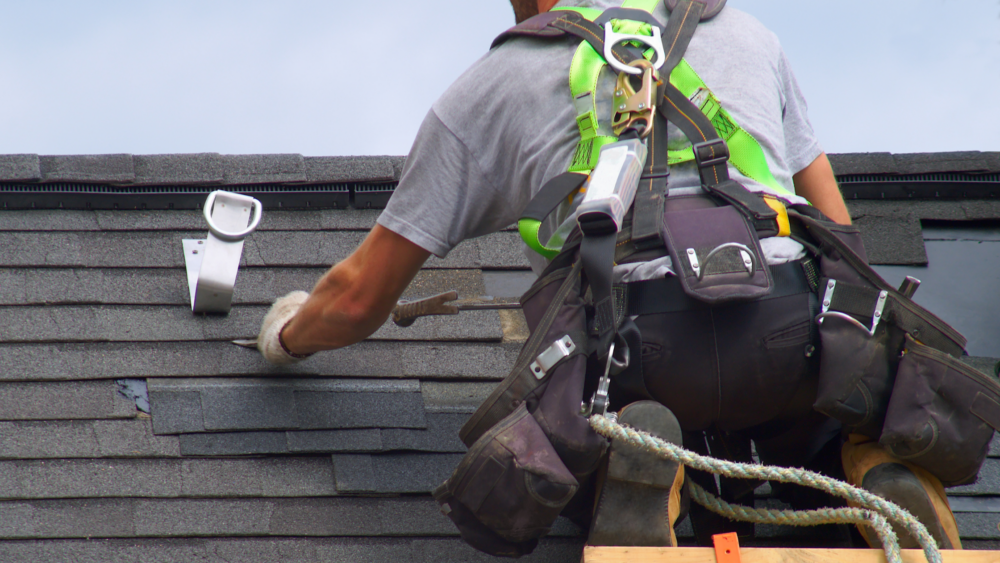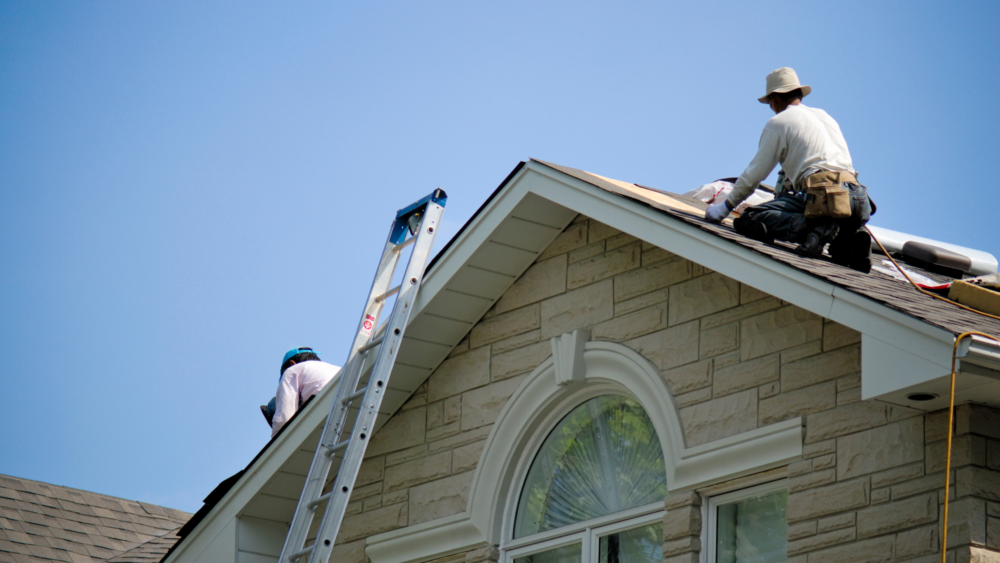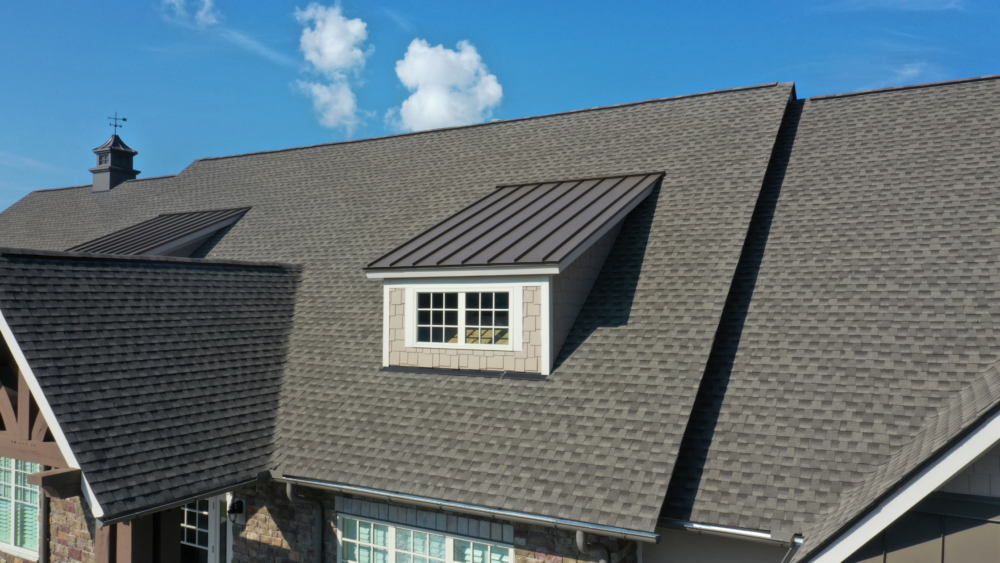Has your homeowners insurance been canceled because of your roof? Don’t panic, in this guide we will uncover why this happens and learn how to prevent it while keeping premiums affordable.
I experienced a deep, unsettling feeling when I observed an envelope from my insurance agency in the post. You’re not alone.
I remember standing on my front porch, envelope in hand. I was expecting another routine bill. But instead…
“Your homeowners insurance has been canceled due to roof conditions.” Bam! It hit me like a rogue shingle ripped loose by an unruly storm.
Suddenly, it felt as if my own protective cover had been peeled away—just like the worn-out tiles of our old family house’s rooftop. The sense of security I’d taken for granted seemed far off and out of reach now.
But why would they cancel because of the roof? How could this happen?
Ever wondered about this, or think you might in the future? Don’t worry. You’re not alone. We’ll dive into it together.
Understanding Homeowners Insurance and Roof Coverage
Homeowners insurance, a safety net for your property, often covers more than you think. Among the crucial aspects of your policy is roof coverage – an area that directly influences how much protection you get.
The roof of a home serves as the primary barrier against inclement weather and other natural hazards. But why does this matter to insurers? The answer lies in understanding risk pooling, which allows insurance companies to manage financial risk.
The Importance of Roofs in Your Policy
A well-maintained roof signifies lower risks for insurers. Conversely, if they spot potential issues with your roofing system, expect higher premiums or even policy cancellation due to increased chances of damage claims.
This gives rise to an interesting dynamic between homeowners and their insurance providers: while we view our homes from an emotional standpoint (it’s where memories are made after all), insurers see them as numbers on a balance sheet.
Risk Pooling Explained
In its simplest form, risk pooling means collecting resources from many people (in this case premiums) so when disaster strikes one homeowner, there’s enough money pooled together by everyone else’s contributions to cover losses. Think about it like sharing umbrellas within a community – even though not everyone will need shelter at once during unexpected showers.
Roof Condition and Its Impact on Policies
National Association Of Certified Home Inspectors‘ report indicates roofs account for over 30% house-related claims making them a key determinant of your policy terms.
A damaged roof is more likely to lead to water damage, mold growth, and structural issues. Thus, the age, type of material used, and overall condition directly influence how much you’ll be paying for homeowners insurance.
Take for example, durable materials like metal or tile. They can cut down your premiums because they’re known to hold up better against harsh weather compared to cheaper alternatives like asphalt shingles. Yes, the upfront costs might be higher for these top-notch materials. But consider this – you’re investing in safety and future savings.

Why Homeowners Insurance Might Be Canceled Due to the Roof
The roof of your home can be a factor in determining if your homeowners insurance will remain valid, as insurers evaluate the age and condition of it when assessing risk. Just as you might not lend your car to someone who’s had multiple accidents, insurers are hesitant about covering homes with roofs that pose significant risks.
Insurance companies use their own risk assessment criteria, which often includes the age and condition of your roof. An older or damaged roof increases chances for claims due to water damage or structural issues. To an insurer, this is like seeing a red flag on a bull—it spells potential trouble.
The Age Factor: Old Roofs Aren’t Always Golden
An old roof isn’t always charming; sometimes it’s just old—and potentially problematic from an insurance standpoint. Many policies have specific rules around roofs over 20 years old because they’re more likely to incur damages during storms or severe weather events.
Aged roofing materials deteriorate faster and offer less protection than newer ones—a fact recognized by most insurance providers. This leads them to reconsider providing coverage for houses with such roofs unless necessary repairs are made promptly.
Matter of Condition: All Cracked Up?
Routine maintenance is key when keeping up appearances—especially if those appearances involve shingles on your rooftop. Visible signs of neglect like missing tiles, cracks, leaks, or moss growth can be a clear signal to your insurance company that it’s time for them to part ways with you.
Remember, insurers are like the police of home safety. They want to make sure everything is in order before they give their seal of approval—your policy. Any signs of disrepair could potentially lead to cancellation unless fixed immediately.
Type Matters: Not All Roofs Are Created Equal
Just as we humans have different preferences, so do insurance companies when it comes to roofing materials. Certain types, such as wood shakes or tar and gravel roofs, pose more risk than others due to their vulnerability towards fire or water damage respectively.
On the other hand, metal and tile roofs usually get a thumbs-up from insurance companies. Why? Well, they not only stand up to extreme weather but also offer top-notch protection.

Signs Your Roof May Lead to Insurance Cancellation
Your roof, though often overlooked, plays a crucial role in your homeowners insurance. It’s the shield that protects your home from weather and damage. But if it’s not up to par, you might find yourself without coverage. Here are some signs that may trigger an alarm for your insurer.
Age of the Roof
The older the roof, the higher its chances of causing problems – much like vintage cars require more maintenance than new ones. Roofs over 20 years old can be a red flag for insurers because they’re more likely to leak or collapse, leading to costly repairs.
Poor Maintenance
Maintenance is key when it comes to roofs – think of it as regular oil changes for your car. If gutters are overflowing with debris or shingles are missing and damaged, this could signal neglect which might prompt insurers to cancel policies due because these issues lead to bigger problems down the line.
Inappropriate Installation
If Bob from next door installed your roof on his day off instead of hiring professionals who know their craft inside out, insurers won’t be impressed. Incorrectly installed roofs pose major risks as they can easily fail during harsh weather conditions resulting in severe damages. A professional installation is essential.
Use of Substandard Materials
If you’ve used cheap roofing materials to cut costs, your insurance company might not be thrilled. Lower quality materials are more likely to get damaged or wear out quickly, leading to frequent repairs and replacements, which could trigger a policy cancellation.
The key takeaway here? Your roof isn’t just the hat for your house – it’s an important factor in keeping your homeowners insurance intact. Keep these points in mind to ensure your roof doesn’t become a reason for insurance cancellation.

Steps to Take If Your Insurance Is Canceled Because of the Roof
The moment you get that dreaded letter stating your homeowners insurance has been canceled due to your roof, it’s easy to panic. However, don’t despair – there is still hope. Take action now.
Step 1: Get a Professional Inspection
Your first move should be to call in an expert for a professional roof inspection. This helps determine if there really is a problem with your roof and gives you more details on its condition.
Step 2: Repair or Replace Your Roof
If issues are found during the inspection, don’t wait around. Start planning repairs immediately. Depending on severity, it might even make sense to replace your entire roof. It may seem costly upfront but think about it as investing in peace of mind and preventing future insurance headaches.
Step 3: Document Everything
Taking pictures before and after repair work provides solid proof that problems have been addressed adequately. Hold onto any receipts related to repairs too; they’re tangible evidence showing how much effort was put into making sure things were done right.
Step 4: Shop for New Insurance
Sometimes getting new coverage after cancellation feels like trying out at ‘America’s Got Talent’ – daunting yet doable. Use resources like Insure.com‘s guide for navigating these waters efficiently while ensuring proper protection against potential damages.
Step 5: Appeal the Cancellation
If you feel your insurance was unfairly canceled, don’t shy away from appealing. After all, even in real life there are opportunities for ‘instant replays’. Reach out to your insurer with evidence of repairs and see if they’ll reconsider their decision.
Break the issue down into smaller, achievable steps to make it more manageable; this can be quite motivating as you get closer to a resolution. Plus, knowing that each action is getting you closer to resolving this issue can be quite motivating. So keep calm and roof on.
Preventive Measures to Avoid Insurance Cancellation
Maintaining your roof is key in preventing homeowners insurance cancellation. But, where should you start? Here are a few practical steps.
Regular Roof Inspections
Home inspections, especially those focused on the roof, play an important role in keeping your coverage intact. By having professionals inspect your roof at least once a year or after severe weather events, you can spot potential issues early and fix them before they become major problems.
Timely Repairs and Maintenance
Don’t wait for minor damages to turn into significant ones before acting. As soon as any damage is identified during an inspection, get it fixed promptly. This will not only save you from hefty repair costs down the line but also help keep your insurance active.
Choosing Durable Materials for Your Roof
The materials used on your roof greatly impact its longevity and performance against harsh elements – factors that insurers consider when evaluating policies. Using durable roofing materials, like metal or slate, may cost more upfront but could lower risks of damage and policy cancellations in the long run.
Safeguard Against Weather Elements
Your geographical location might expose your home to specific hazards such as hurricanes or heavy snowfall which can wear out roofs quickly if not properly safeguarded against these elements. Installing features like hurricane straps or ice shields can give extra protection thereby reducing chances of insurance termination due to roof damage.
Stay on Top of Record Keeping
Keep all your roofing maintenance and repair records organized. If an insurer questions the condition of your roof, these documents will be tangible proof of your efforts to maintain it well. Gather and store all relevant records in one accessible location to ensure you have evidence of your roofing maintenance efforts should an insurer question the condition.
Taking these preventive measures seriously can not only extend the lifespan of your roof but also keep insurance cancellation at bay – saving you stress and money down the line.
Navigating the Process of Getting New Insurance After Cancellation
Getting your homeowners insurance canceled because of your roof can be a stressful experience. But, there’s no need to panic. With some careful steps and proactive measures, you can get back on track.
Shop Around for New Providers
The first step is to start shopping around for new insurance providers. Don’t settle with the first one you find; instead, make sure to compare rates from different companies as suggested by experts at Insurance.com. Each company evaluates risk differently, so their quotes may vary greatly.
Understand Policy Terms Clearly
In this quest for a new policy, understanding each provider’s terms becomes critical. Knowing what is covered under ‘dwelling coverage’ or ‘personal property coverage’, as well as limits and deductibles will help you choose wisely. Learn more about homeowners insurance terms on Investopedia.
Negotiate Rates Wisely
Once you’ve found potential providers and understood their policies thoroughly, it’s time to negotiate rates effectively. Ask about discounts they offer like bundling home and auto insurance or installing security systems which might lead to more savings according to the Consumer Financial Protection Bureau (CFPB).
Rework on Your Roof
While you’re navigating the insurance market, don’t forget about your roof. If it’s in poor condition, consider getting it fixed or replaced to avoid future policy cancellations. A reliable roof that is kept up-to-date can be a benefit for insurance firms. Learn more about roof maintenance on This Old House.
Documentation Is Key
And remember, it’s crucial to keep a detailed record of every step you take in this process.
Impact of Roof Condition on Insurance Premiums
Your roof is like a helmet for your home. It shields you from the elements, but when it’s worn out or damaged, it may not do its job as well. This can make your house more vulnerable to damage, and insurance companies know this.
Just like how you’d want a sturdy helmet while riding a bike, insurance providers prefer homes with roofs in good condition because they’re less likely to need claims for repair work. A study from Insurance.com demonstrated that those with aged or damaged roofs may pay up to 20% more on their premiums than those having newer ones.
This increase isn’t arbitrary – there’s solid reasoning behind it. Older roofs are more prone to leaks which can lead to water damage inside the home – an expensive fix. But also structural problems such as mold growth and rotting woodwork beneath shingles are often unseen until too late.
The Good News About Maintaining Your Roof
Maintaining your roof isn’t just about avoiding issues—it can actually save you money in the long run.
A well-maintained roof signals lower risk for insurers; hence they tend offer lower premiums—similarly how safe drivers get discounts on car insurance rates.
Risk Factors That Could Raise Your Premiums
- Type of material: Some materials are pricier than others because they’re harder to replace or repair if damaged.
- Lifespan left: Roofs have finite lives—the closer yours is toward its end, the more you might have to pay.
- Previous claims: If your roof has been involved in insurance claims before, that could raise red flags for insurers and lead to higher premiums.
The Impact of Your Location
Your location also plays a part. Expect your insurance premiums to be higher if you live in an area with frequent extreme weather conditions such as hailstorms or hurricanes due to the increased risk of roof damage.
To wrap it up, staying on top of your roof’s regular upkeep can help keep insurance expenses in check. Not only that, but it also ensures your home remains safeguarded against the forces of Mother Nature.
FAQs in Relation to Homeowners Insurance Canceled Because of the Roof?
Can a roof be too old for insurance?
Absolutely, insurers often balk at covering roofs over 20 years old. They see older roofs as high risk due to wear and tear.
What reasons can homeowners insurance drop you?
Your insurer may drop you for several reasons including excessive claims, risky property conditions or if your home’s upkeep isn’t up to snuff.
Is it hard to get homeowners insurance after being dropped?
Yes, but not impossible. You might face higher premiums though because companies view previous cancellations as a red flag.
What voids homeowners insurance?
Fraudulent claims, intentional damage or misrepresentation on your application are quick ways to have your policy nullified by the insurer.
Conclusion
Understanding your homeowners insurance, especially when it comes to roof coverage, is crucial. It can mean the difference between a secured home and a nasty surprise letter in the mail.
Your roof’s age, condition and material matter. They’re key reasons why your policy might be canceled.
A sagging or leaking roof could spell trouble. But don’t panic if you find yourself with “Homeowners Insurance Canceled Because of the Roof”. There are steps to take: get an inspection, fix up your rooftop and start shopping for new coverage.
Prevention is better than cure though! Regular maintenance checks on your roofing can help avoid cancellation issues later down the line.
If worst comes to worst and you need new insurance after being dropped? No worries – shop around for providers that match your needs at affordable rates.
No Hassle Estimates
We have a nationwide network of the best local contractors ready to quote your project. Get estimates on windows HERE.




